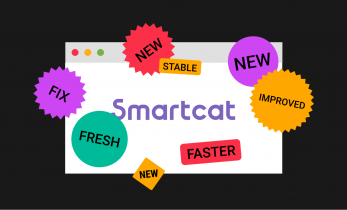Greater than 6 minutes, my friend!
SDL Trados Studio 2015 Review
SDL recently released Trados Studio 2015, the new version of its popular CAT tool. After weeks of putting several beta versions and a few release candidates to the test, I can finally publish my review and rating for the new Studio. In this blog post you will read my Trados Studio 2015 review and an overview of new features.
A general note on Trados Studio 2015
Trados Studio 2015 is the natural successor of Trados Studio 2014 and the fourth generation of Trados Studio – Before Studio 2014, Studio 2011 and Studio 2009 were introduced. Trados Studio is a popular CAT tool and a descendant of the oldest CAT family in the industry. The software is released just a month after MemoQ 2015 and when SDL’s Paul Filkin (Director Client Communications) announced some new features on Twitter, MemoQ replied that they introduced the same in their software. So not everything in Trados Studio 2015 is revolutionary or something that makes Studio 2015 stand out from its competitors, but there’s enough to write on the new piece of software.
Trados Studio 2015 new features
Trados Studio 2015 comes with new features that make the software quite a bit more interesting for translators who want to update from Trados Studio 2014 and even more interesting for users who are still using Studio 2011 or 2009. A short overview follows below. A more detailed explanation is following afterwards.
- Trados Studio 2015 comes with a flat and neat GUI
- Retrofit: update the translation file (and memory) from a reviewed target file
- Auto-correct spelling or insert frequently used text easily
- Personalized ribbon
- Use AutoSuggest for every kind of match
- Leverage from TMs with other language pairs
- Create and manage bookmarks
- Exclude locked segments from the analysis
- Support for new Microsoft Office 2016
- New GUI languages: Korean and Italian (for what it’s worth if you don’t master these languages)
- Work with bilingual Excel files
Which new features in Trados Studio 2015 you consider important is depending on your preferences and the way you use the CAT tool. I will therefore only review the new features that catched my eye. You will find them below.
Trados Studio 2015 GUI
The introduction of Trados Studio 2014 already brought a new graphical user interface. Trados Studio 2015 elaborates on that and introduces an even cleaner GUI. Although it looks smooth, it works a bit confusing sometimes. In fact, there is sometimes little distinction between buttons and that makes it hard to find the right features at a glance. It seems that the new ribbon is packed with buttons and therefore you sometimes need to search a bit longer to find the button you need. Avid Studio 2014 users should also learn to deal with different designed icons, which make the learning curve a bit steeper than should be necessary for people that are already used to Trados Studio.
On the other hand Trados Studio 2015 brings some new graphical features like colors in the status bars of the preparation stage. The status bar for stages that are less than 30% processed is red, changing to orange and to green. Not very useful, but at least it provides some basic information in a split-second.
Ribbon customization
New in Trados Studio 2015 is the possibility to change the content of the ribbon. This enables you to combine the features you use most, quite helpful in speeding up your work. You can make the ribbon as concise or extended as you prefer. You will find this feature under ‘View’ > ‘User Interface’ > ‘Ribbon Customization’.
Trados Studio 2015 Retrofit
Trados Studio 2015 also brings Retrofit. This option enables you to export a clean target file to send to your customer. Your customer can make amendments then which you can import into the bilingual file. You will be presented with an overview of the changes the client made.
Retrofit is quite helpful in that it offers a work-around for bilingual review documents. Personally I like these review documents, but normally clients would prefer to receive a clean file as it is easier to work with and because it removes one layer of review and communication. I bet Retrofit will sometimes result in errors caused by formatting changes, but it is a great start as it avoid frustration and offers a quick way to keep both documents and TMs up to date.
Trados Studio 2015 Auto-correct
Another new feature in Trados Studio 2015 is Auto-correct. This feature is already present in MemoQ for a long time. Basically it auto-capitalizes the first word in a segment or correct words with two consecutive CApitals. SDL also mentioned that this feature auto-correct regularly misspelled words, but I was unable to find that out. Perhaps it only works with an English dictionary. Fortunately auto-correction for capitals is not as rigid as in MemoQ, where you need to write the first letter of a segment twice and remove the capital before confirming the segment in order to write without capitals. In Trados Studio 2015 w0rds are capitalized automagically, but hitting Ctrl + Z (undo) will undo that. You can also change the auto-formatted uppercase into a lowercase letter without fear that Trados Studio 2015 will capitalize it again. A small but nice improvement!
Not entirely Auto-correct, nor Auto-suggest is an option that comes up when you confirmed a segment but want to change the word order. It registers the keys you press in order to type a word and comes up with words and even whole parts of the sentence to avoid that you should type words again and again. Please find a sample below. It doesn’t work all the time and it works for a particular segment only, but it can be helpful when it comes to reviewing and editing a text.
Trados Studio 2015 TM leverage
For those who work in language pairs with several sub-pairs, like English and Dutch, this feature brings a good improvement. You can now use TMs with different language pairs. That is pretty nice because sometimes a second TM can shed new light on terms. Trados Studio 2014 was quite rigid in the contrary, but people developed an extension for it. Now it works like a charm.
Trados Studio 2015 Bookmarks
An other interesting new feature in Trados Studio 2015 are the bookmarks. You can now add a bookmark to a project and use it to look up a particular segment easily. And to avoid fuzz you can also manage and remove bookmarks. Unfortunately bookmarks are not visible by icons and you should click ‘Advanced’ > ‘Bookmarks’ > ‘View Bookmarks’ to open a small panel with an overview of bookmarks. You can jump between bookmarks in currently opened documents, projects, all opened documents and any documents. Particularly the first two options are of interest. For me it makes most sense to work with bookmarks in a particular document or project. Indeed you can only work on one document a time…
Trados Studio 2015 Exclude locked segments
Trados Studio 2015 contains yet another feature that is already present in MemoQ: excluded locked segments from the analysis. The benefit of this is that you neither need to subtract the word count in locked segments manually from a log, nor need to use segment statuses (like ‘Translation rejected’) to make sure what actual word count you need to translate. Useful option for providing insight in the actual word load!
Trados Studio 2015 Bilingual Excel files
A new feature I didn’t find but which was highly appreciated by the Studio beta testers was the option to import bilingual Excel files. This option enables you to work with several columns and comments and to import them into Trados Studio 2015 as a workable file, something that was impossible until now. I will write a note about it in the future.
Trados Studio 2015 review: the final word
As always I was pretty soon in registering for an upgrade discount for Trados Studio 2015. Trados Studio is still the most popular CAT tool on earth, although many companies seem to chose for MemoQ lately. Trados Studio furthermore has proven not to be compatible with all (legacy SDL) files. Registering for the upgrade discount therefore was merely on the spur of the moment than because I really needed.
I’m nevertheless sure that Studio offers many improvements. If you own both MemoQ and Trados Studio you can safely consider which of both you want to keep because they’re growing closer in their functionality and compatibility. I think Trados Studio 2015 is of particular interest for professional translators who want to start easily with a CAT tool that offers a multitude of advanced options in a user friendly format.
Trados Studio 2015 supports the new MS Office 2016 file format which is not yet published. Support for Excel 2016 will follow later on. Despite that (and considering that it is not yet quite necessary to support them) I can surely recommend you to buy or upgrade it. But if you upgrade: consider to take some time to get used to the new flat interface.









Thank for the review, Pieter! This information is rather useful for those who are about to purchase this solution.
Thanks Simon!
Just finding the right modus for this platform 😀
+1, Pieter. This is also how see it: This release is one of the best excuses to upgrade.
Yes, that’s certainly a trick 🙂
On the other hand, there are so much new developments in many fields that it certainly is worth to come up with an update every few years. However, only now many agencies have adopted Studio 2014 so there’s no urgent need to buy your upgrade 🙂